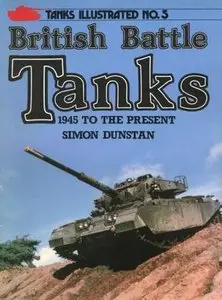Simon Dunstan - British Battle Tanks 1945 to the Present
Arms And Armour Press | 1983 | ISBN: 0853686025 | English | 70 pages | PDF | 57.3 MB
Tanks Illustrated No. 5
Arms And Armour Press | 1983 | ISBN: 0853686025 | English | 70 pages | PDF | 57.3 MB
Tanks Illustrated No. 5
During the Second World War, British tanks were generally inferior to their German opponents with respect to their firepower and armour protection, while their high mobility in the early years was severely compromised by chronic unreliability. Since the war British designers have consistently pursued a policy that would prevent British troops ever taking the field again with tanks of inferior armour and armament. Unlike the European school of thought which advocates high mobility and firepower to ensure survival on the battlefield, the British consider that firepower is the primary attribute of a tank in defeating enemy armour at long ranges, followed closely by heavy armour protection to enable it to absorb punishment and manoeuvre at close quarters with relative immunity in a theatre of high-intensity warfare. Immediately after the war Britain abandoned the misguided doctrine of dividing tanks into 'Cruiser' and 'Infantry' types and adopted the idea of a 'Universal' or 'general purpose' tank, later to be known as the 'Main Battle Tank'. The first of these was Centurion, an excellent design capable of being repeatedly upgraded. Originally armed with the 17pdr, it was subsequently fitted with the 20pdr and finally the 105mm gun; the frontal armour was increased and fuel capacity more than doubled. Its successor, Chieftain, was designed from the outset to mount the most powerful and effective gun feasible, with a range of ammunition capable of defeating different armour arrangements at considerable range. The latest British Main Battle Tank is Challenger. It incorporates the latest developments in tank technology, including advanced compound armour, a computerised fire control system and thermal-imaging equipment for night fighting. Challenger is the product of more than 60 years of British tank development and is one of the foremost AFV designs in the world. The photographs on the following pages form a representative cross-section of the principal battle tanks employed by the British Army in the past forty years. In preparing them for publication I wish to thank the public relations departments of the Ministry of Defence; HQ Royal Armoured Corps Centre; National Army Museum; James Haddon; Vickers Defence Systems; and Les Wiggs of Soldier Magazine.



